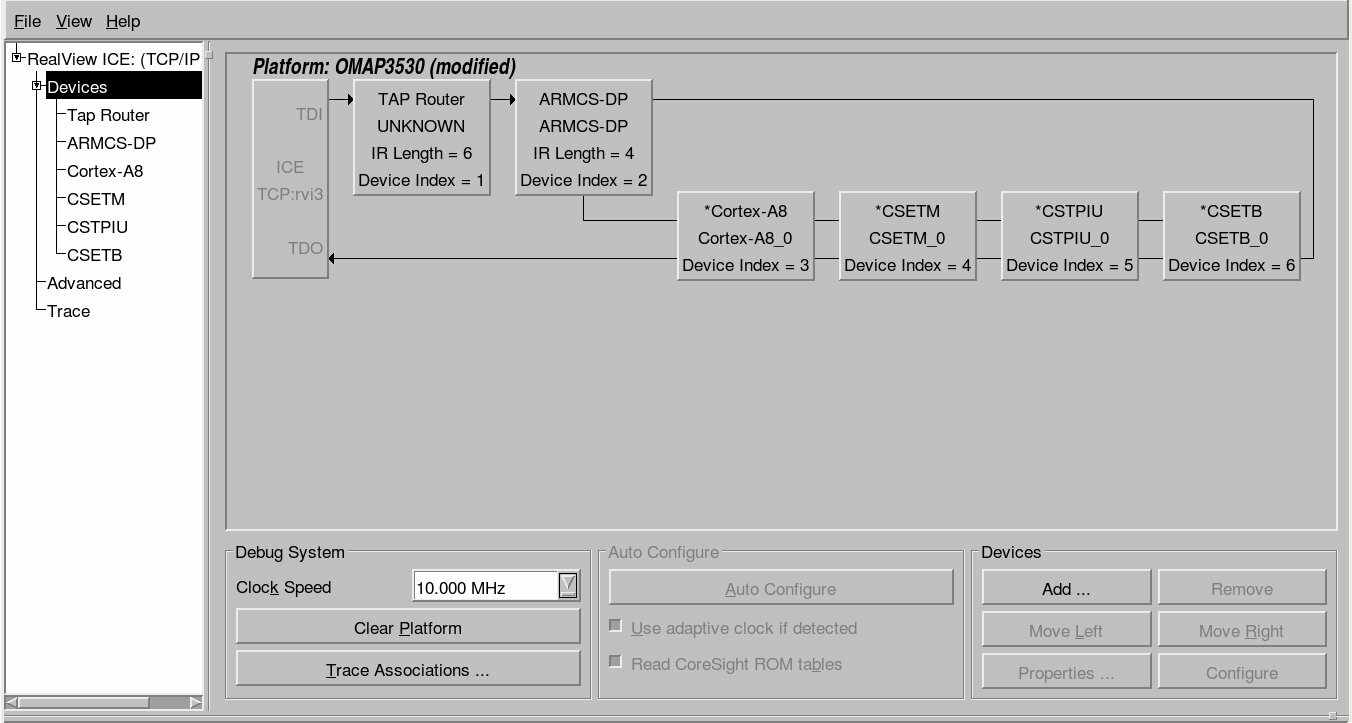The new release of software (3.3) for the RealView ICE supports Texas Instruments' range of OMAP3 processors. An interesting feature of the OMAP3 family of processors is that the ARM Cortex-A8 core is not automatically added to the scan chain and cannot be auto-detected. Instead the OMAP3 uses a TAP router (JTAG Route Controller) that must be programmed with what is available on the chain. Luckily ARM has provided "templates" for the OMAP3 family that allow the user to select which processor they have connected to. The template provides the RealView ICE all it needs to know for easily connecting to the ARM core. An example of the OMAP3530 scan chain is shown below.  Also be aware that TI uses a non standard 14 pin JTAG connector. If you need to connect any of the standard ARM JTAG tools to a TI (such as the OMAP3 family) processor, you will need a TI JTAG adapter such as the ARM provided HBI-0027B (Schematic). Make sure you mention you need to connect to a TI device when you purchase your next RealView ICE!
Also be aware that TI uses a non standard 14 pin JTAG connector. If you need to connect any of the standard ARM JTAG tools to a TI (such as the OMAP3 family) processor, you will need a TI JTAG adapter such as the ARM provided HBI-0027B (Schematic). Make sure you mention you need to connect to a TI device when you purchase your next RealView ICE!

TI OMAP3 JTAGPosted in Uncategorized on December 11, 2008 by Administrator Nvidia and ARMPosted in Industry News on August 18, 2008 by Administrator It has been a bit over two years since the Nvidia license was announced. At the time we were promised high definition video and high performance chips with a graphics focus. It takes a couple of years for a new licensee to get their feet under the table, so it's a good time to have a quick look at the results. This video shows some of the technology at work: It certainly looks compelling. From the specs, it can drive an large HD display as well as a Blu-ray player. Another video is (HTC Touch Diamond) showing the Opera browser. Nvidia has recently named their ARM line 'Tegra'. This is a 700MHz ARM11 MPcore (multi-core CPU) with high-end graphics capability. Support on the web site looks weak, and it seems to be aimed at Windows. The HTC Advantage is one consumer product I can see with this technology. It uses Windows too. The target market seems to be tier 2/3 Asian manufacturers of electronic gadgets. Nvidia sees its competition as the Intel Atom, but this is a strange choice. Sure, Tegra looks great against the Atom - 1/10th the size and 10th the power, they claim. But most ARM SOCs look good against the Atom. How does it stack up against TI's OMAP3530, for example? Surely this is the real competition - no one in their right mind is going to put Atom into a small mobile device. The focus on Windows perhaps just reflects the market they are in - as reported on Linux devices: Asked about future Linux support, NVidia Spokesperson Andrew Humber replied, "Market demands will always dictate the direction in which we take a product, and this is true of all of NVidia's businesses. However, at this time we are focused entirely on Windows Mobile and Windows CE."This is in strong contrast to both Intel and TI, who go to great lengths to support Linux on their products. Is Nvidia persuing the right strategy here? There is no need to argue with Intel about the merits of using ARM versus x86 in mobile devices - that argument was surely won years ago. And the focus on Windows (while it has advantages in concentrating Nvidia's limited resources into a single platform) plays into Intel's 'we are x86' story, and allows people to pidgeon-hole Nvidia into a customer base with limited software expertise and little chance of producing an iPod-killed. Could Nvidia aim higher? |



